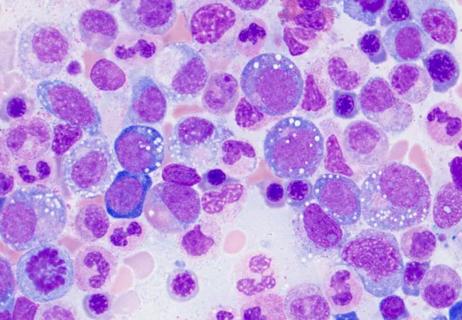Study examines the acceptance of PROMs in a large series of rheumatology patients

A study conducted in adult rheumatology patients treated at Cleveland Clinic found that patients overwhelmingly perceived the Patient-Reported Outcomes Measures (PROMs) as useful, easy to understand and informative about their condition. Patients also reported that PROMs improved communication with their provider and helped them gain better control over their own care. The study, published online in November 2020 by Quality of Life Research, is the first to examine the perception of and experience with PROMs in such a large series of rheumatology patients.
Advertisement
Cleveland Clinic is a non-profit academic medical center. Advertising on our site helps support our mission. We do not endorse non-Cleveland Clinic products or services. Policy
“The major goal of the study was to assess the patients’ experiences with completing PROMs,” says Cleveland Clinic researcher Brittany R Lapin, PhD, the study’s corresponding author. An additional goal, she adds, was to assess the patients’ perception/acceptance of additional questions that were recently added to rheumatology PROMs across Cleveland Clinic.
Prior to rheumatology visits, patients are asked to complete PROMs through MyChart or on tablets in the waiting room. The PROMs include a depression screen and surveys assessing physical function, fatigue, pain interference, and overall health-related quality of life. The purpose of PROMs in clinical practice is to evaluate the impact of disease from the patient’s point of view in order to monitor response to treatment and overall progress in controlling their disease. An added goal of these detailed questionnaires is to facilitate patient-provider communication, help clinicians gain a better understanding of the patients’ overall health, and empower the patient to participate in shared decision making.
Dr. Lapin explains that PROMs have proven to be especially relevant in rheumatology due to their ability to convey a patient’s perspective on their health, irrespective of clinical findings.
“In rheumatology it seems that clinical tests are not always indicative of how a patient is feeling day to day, or how their quality of life is, so they really help to get a patient’s perspective for the clinician,” she says. “PROMs are used enterprise-wide at Cleveland Clinic…and rheumatology has a couple of extra condition-specific measures where patients respond about fatigue and pain interference.” She adds that the response rate of 76% is considered very high.
Advertisement
In explaining the utility of PROMs further, Rheumatology Department Chair and study co-author Abby Abelson, MD, FACR, says that rheumatic diseases affect many different organ systems in the body and that getting an accurate assessment of all the ways in which the disease is affecting the patient at the point of care is critical. “One of the things that’s unique about PROMs is that they’re conducted at the point of care, and not retrospectively,” she adds. “They ask — how do you feel now — and if you start every visit with that question, it really focuses the whole visit on the patient.”
Insights from PROMs can prompt the clinician to communicate with a patient about concerns that may have been missed based on clinical findings alone, she adds. “Sometimes it’s a side effect from a medication or something else entirely unrelated to their illness.”
The retrospective cross-sectional study included 12,597 adult (76% female and 84% white) rheumatology patients seen across Cleveland Clinic rheumatology clinics between January 1, 2017 and June 30, 2017. Patients included in the study completed at least one patient-reported experience question after completing their PROMs. They overwhelmingly found PROM questions to be useful (84%) and easy to understand (97%). Furthermore, 78% of patients felt that PROMs improved their physician’s understanding of their health and their communication with the provider.
“Patients were overall very positive about their experience,” says Dr. Lapin. “Personally, I think that some of the more exciting findings here are that we found predictors of who had a more positive experience.” This included patients who were younger, non-white, had lower income, and were depressed and reported a lower quality of life. She believes that PROMs are especially important in these patient populations who frequently face health disparities, and that completing PROMs may be a simple and effective way to reduce them.
Advertisement
An additional finding was that the younger, lower income and more depressed patients were more likely not to complete PROMs even though they were more likely to benefit from them. “So, even though the completion rate is very high in rheumatology, one of the limitations is that there is this responder bias wherein the patients who could benefit the most aren’t completing them,” says Dr. Lapin. “So, I think our findings suggest that there should be greater outreach to all patients to make sure that they are completing PROMs.”
Both authors agree that one of the main strengths of their study was that it included a large number of rheumatology patients with various rheumatic diseases who were seen across a large number of sites and providers. The study’s main limitation, Dr. Lapin adds, is that it did not assess whether the providers reviewed and discussed the PROMs with the patients during office visits, which is what primarily drives the patient satisfaction with PROMs.
Advertisement
Advertisement

New clinic meets Hispanic patients where they are

Several factors masked the cause of the patient’s chronic condition

Patient with previous neurological, bone and hematologic involvement presents with hematemesis

Coordinating care across multiple disciplines

A broad differential diagnosis

From methotrexate for RA, to the treatment of HIV and multicenter randomized trials, Cleveland Clinic has long been at the forefront in the field of rheumatology

The identification of a novel disorder: the VEXAS syndrome

Varied platforms maximize opportunities for interactive, problem-based learning